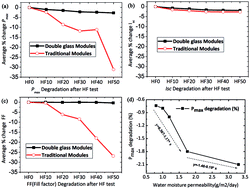Long-term reliability of silicon wafer-based traditional backsheet modules and double glass modules†
Abstract
An extensive program of series extended sequential long-term reliability stress including thermal cycling (TC) 600, damp heat (DH) 3000, 600 hours potential induced degradation (PID) and humidity freeze (HF) 50 were performed on silicon wafer-based traditional backsheet modules and double glass photovoltaic (PV) modules. The relative module maximum power (Pmax) degradations of traditional backsheet modules are 3.87%, 7.34%, 13.3%, 33.73% and those of double glass modules are 2.78%, 3.12%, 2.27%, 2.72%, respectively. From all the above results, HF50 has a greater impact on Pmax degradation of traditional backsheet modules, and a strong correlation is thereby found between the Water Vapor Transmission Rate (WVTR) of the backsheet and the Pmax degradation. Traditional backsheet modules have higher WVTR and greater Pmax degradation, while double glass modules are impermeable and have much lower Pmax degradation. The key factor for excellent performance of Si wafer-based double glass PV modules is replacing the polymer backsheet by a glass panel with impermeability to water vapor, which enables double glass modules to offer much higher reliability and longer durability.


 Please wait while we load your content...
Please wait while we load your content...